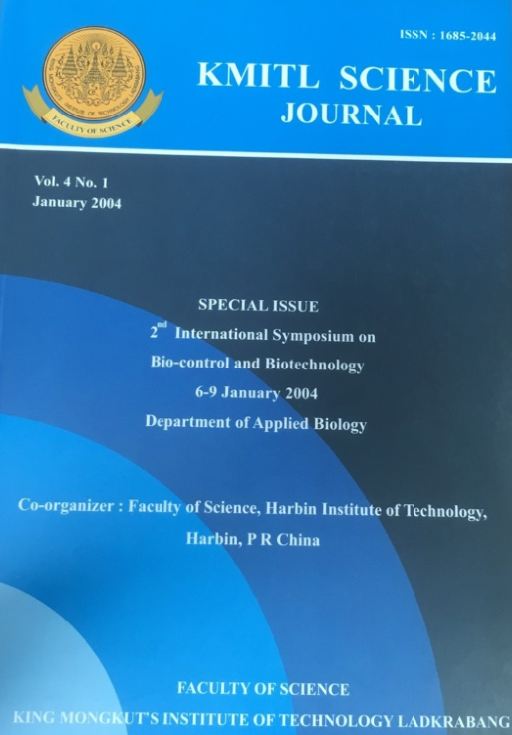Utilization of Trichogramma Parasitoid as Biological Control Agent against Sunflower Headworm Helicoverpa armigera Hubner
Main Article Content
Abstract
The study evaluated Trichogramma parasitoid as a potential biological control agent against sunflower headworm. The aims were to determine the most effective Trichogramma species in parasitizing sunflower headworm egg, to evaluate the effectiveness of different rates of Trichogramma chilones application and to compare the use of Trichogramma and insecticide on the yield of sunflower.
Results show that of the four Trichogramma species tested T. chilones proved to be the most efficient in parasitizing Helicoverpa armigera eggs. Percentage parasitism, percentage sunflower seed set and yield of sunflower were greatly affected by the rate of application of T. chilones. When applied at the rate of 70,000 parasites per hectare per release, T. chilones was effective in parasitizing sunflower headworm eggs, thus increasing sunflower seed sets and consequently sunflower yield. Application of T. chilones was superior to insecticide treatment in controlling sunflower headworm.
Keywords: -
Corresponding author: E-mail: cast@kmitl.ac.th
Article Details
Copyright Transfer Statement
The copyright of this article is transferred to Current Applied Science and Technology journal with effect if and when the article is accepted for publication. The copyright transfer covers the exclusive right to reproduce and distribute the article, including reprints, translations, photographic reproductions, electronic form (offline, online) or any other reproductions of similar nature.
The author warrants that this contribution is original and that he/she has full power to make this grant. The author signs for and accepts responsibility for releasing this material on behalf of any and all co-authors.
Here is the link for download: Copyright transfer form.pdf
References
[2] M.C. Alba, Trichogrammatids in the Philippines. Philipp. Ent. 7(3), 1988, 253-271.
[3] T.M. Aganon, 1989. Management of Arthropod Pests Affecting Soybean with Emphasis in the Soybean Podborer Etiella zinckevela. University of the Philippines, Los Baños, Ph.D.Thesis.
[4] C.R. Baltazar, Import and export of biological control agents in the Philippines (1950-60). Philipp. J. Agric 28 (1-2), 1963, 1-30.
[5] C.R. Baltazar, Biological control attempts in the Philippines. Philipp. Ent. 4(6), 1981, 505-523.
[6] E.P. Cadapan, 1986. Trichogramma parasitoid: production and utilization in the Philippines. Professional lecture delivered on Oct. 24, 1986 at the Plant Pathology lecture hall, UPLB, College, Laguna
[7] E.P. Cadapan and P.G. Gonzales. 1981. Steps in the mass production of Trichogramma species and their host species and their host Corcyra cephalonica. NCPC Yearend Report.
[8] E.P. Cadapan and P.G. Gonzales. 1986 Trichogramma mass production procedure for the village level. A terminal report submitted to R.P. – German Cotton Project. 18. Pp.
[9] P. Debach, 1973. Biological control of insect pests and weeds. Chapman and Hall, London.
[10] R. Famoso, 1990. Biology of Trichogramma spp. and their effectiveness as a biological control for cotton boll worm. Helicoverpa armigera in the Cotton Research and Development Institute (CRDI).
[11] L.O. Icayan, 1978. Biological study of headworm (Helicoverpa armigera). Unpublished B.S. thesis. Central Luzon State University, Muñoz, Nueva Ecija.
[12] E.D. Magallona, A.W. Tejada, L.M. Varca and V.C. Mallari, Jr., Insecticide residues in vegetables. I. Methyl parathion, mevinphos and triazophos residues in cabbage. Phillipp. Ent. 3 (5-6), 1977, 261-271.
[13] M.J. Morales 1991. Trichogramma parasitoid against tomato fruit worm (Helicoverpa armigera Hubner) and eggplant tip borer (Leucinodes orbonalis Quenee). B.S. thesis. Central Luzon State University, Muñoz, Nueva Ecija.
[14] M.L. Perez and E.P. Cadapan, The efficacy of Trichogramma species as biological control agents against some rice insect pests. Philipp. Ent. 6(5), 1986, 463-470.
[15] V.E. Ramos and B. Morallo – Rejesus, Effects of natural and synthetic diet on the growth and development of the corn earworm. Helicoverpa armigera. Philipp. Ent. 4(5), 1981 : 383-387.
[16] R.G. Reloba, M. Coli, A.S. Garcia and F.B. Castro, Preliminary study in biocontrol of Asian corn borer using Trichogramma evanescens. Plant Protection News. 5(3&4), 1985, 24-28.
[17] W.H. Reissig, E.A. Heinrich, J.A. Litsinger, K. Mooety, L. Fielder and A.T. Barrion. 1986. Illustrated guide to integrated pest management in tropical Asia. IRRI, College, Laguna.
[18] Research Office. 1989. Technoguides for Agricultural Production and Livelihood Projects (Based on Research Findings). Research, Extension and Training, CLSU, Muñoz, Nueva Ecija.
[19] Stiiner et al. 1974. Biology of Trichogramma semifumatum and its effectiveness as a biological control for cotton boll worm found in Texas.
[20] STINNER et al. 1977. Efficacy of Trichogramma Chilotraea against Helicoverpa armigera in tomato and potato found in India.
[21] H.S. Torreno and E.P. Cadapan, Laboratory studies on two Trichogramma species against the eggs of Helicoverpa armigera (Hubner). Philipp. Ent. 6(2), 1984, 151-159.


